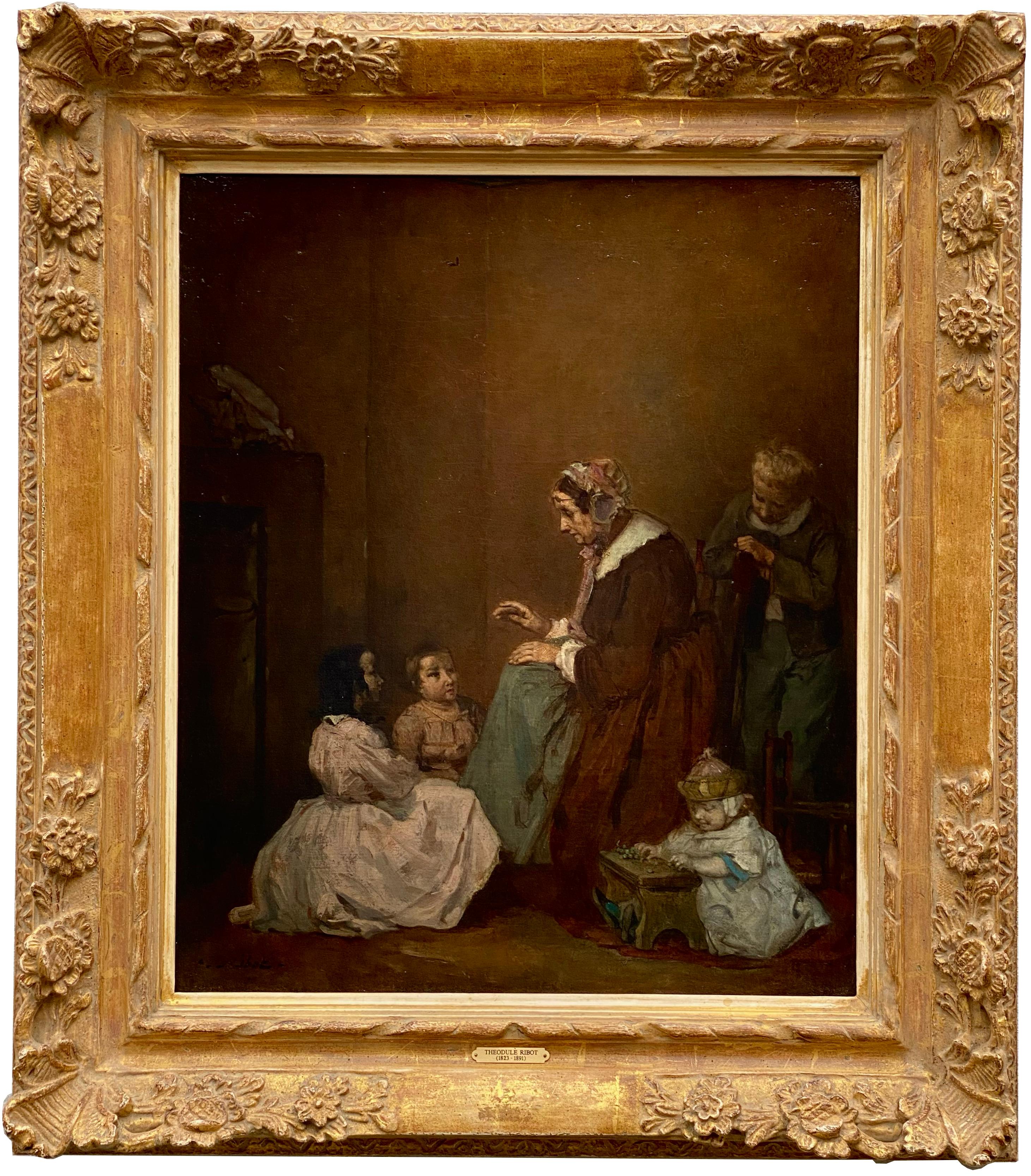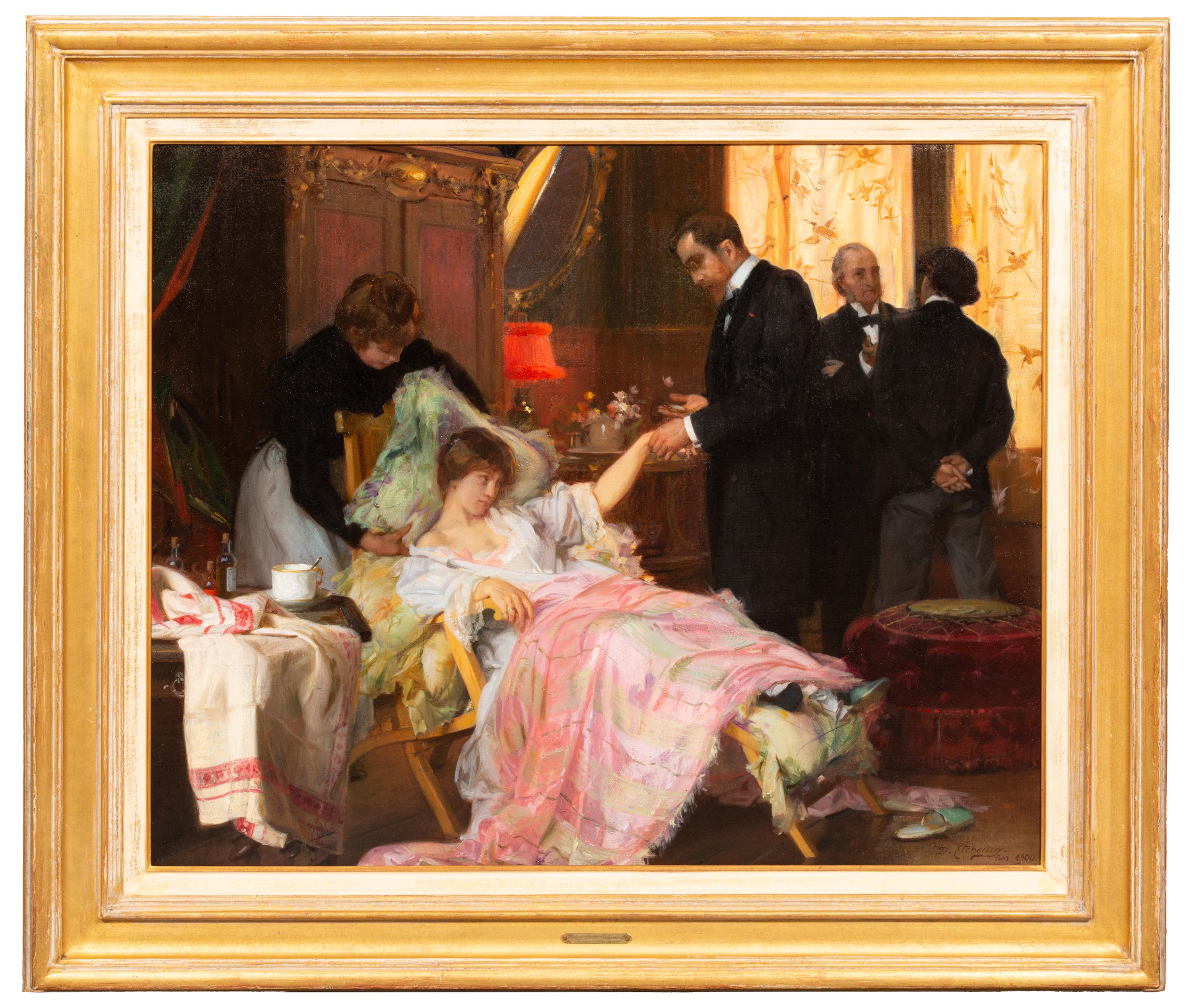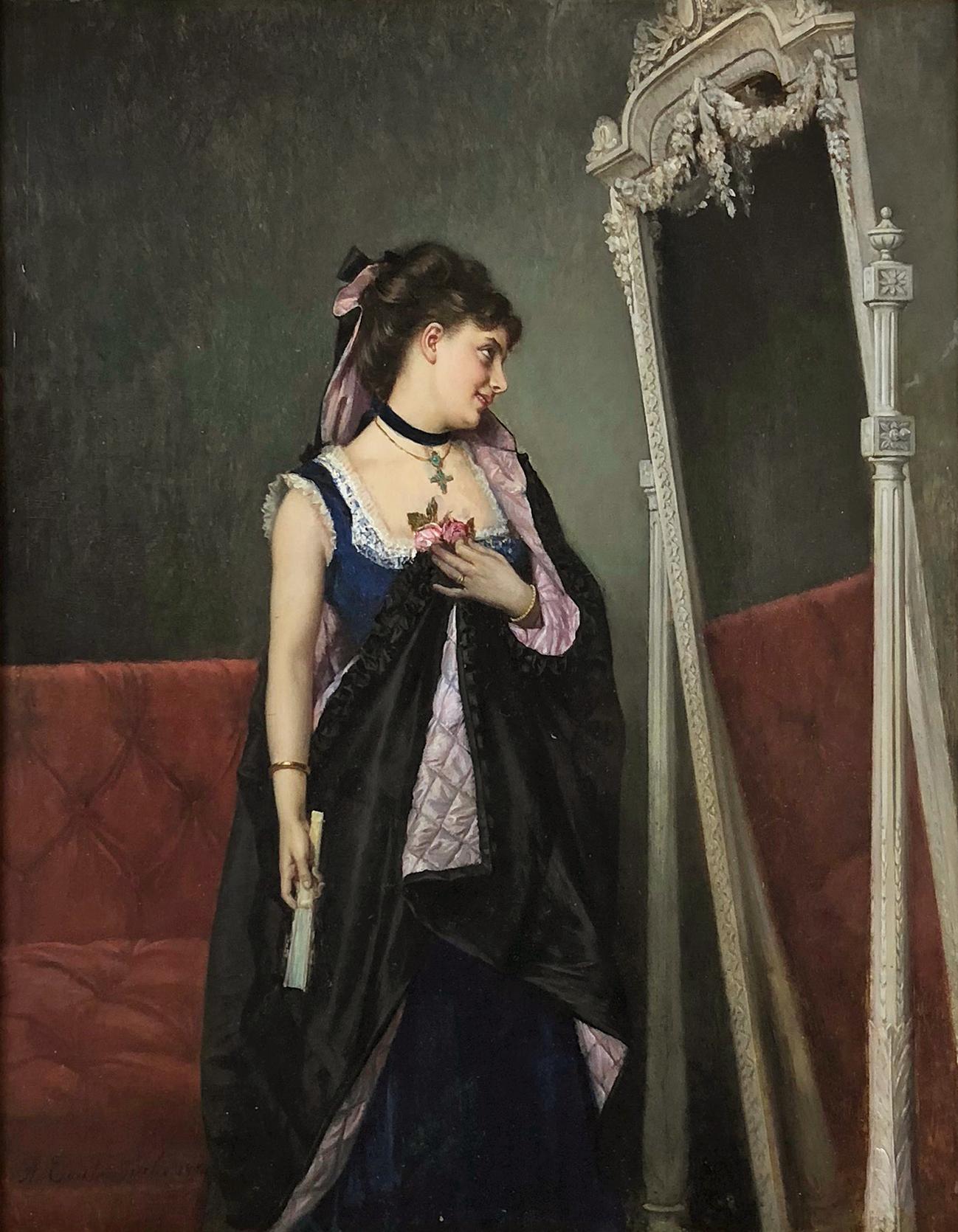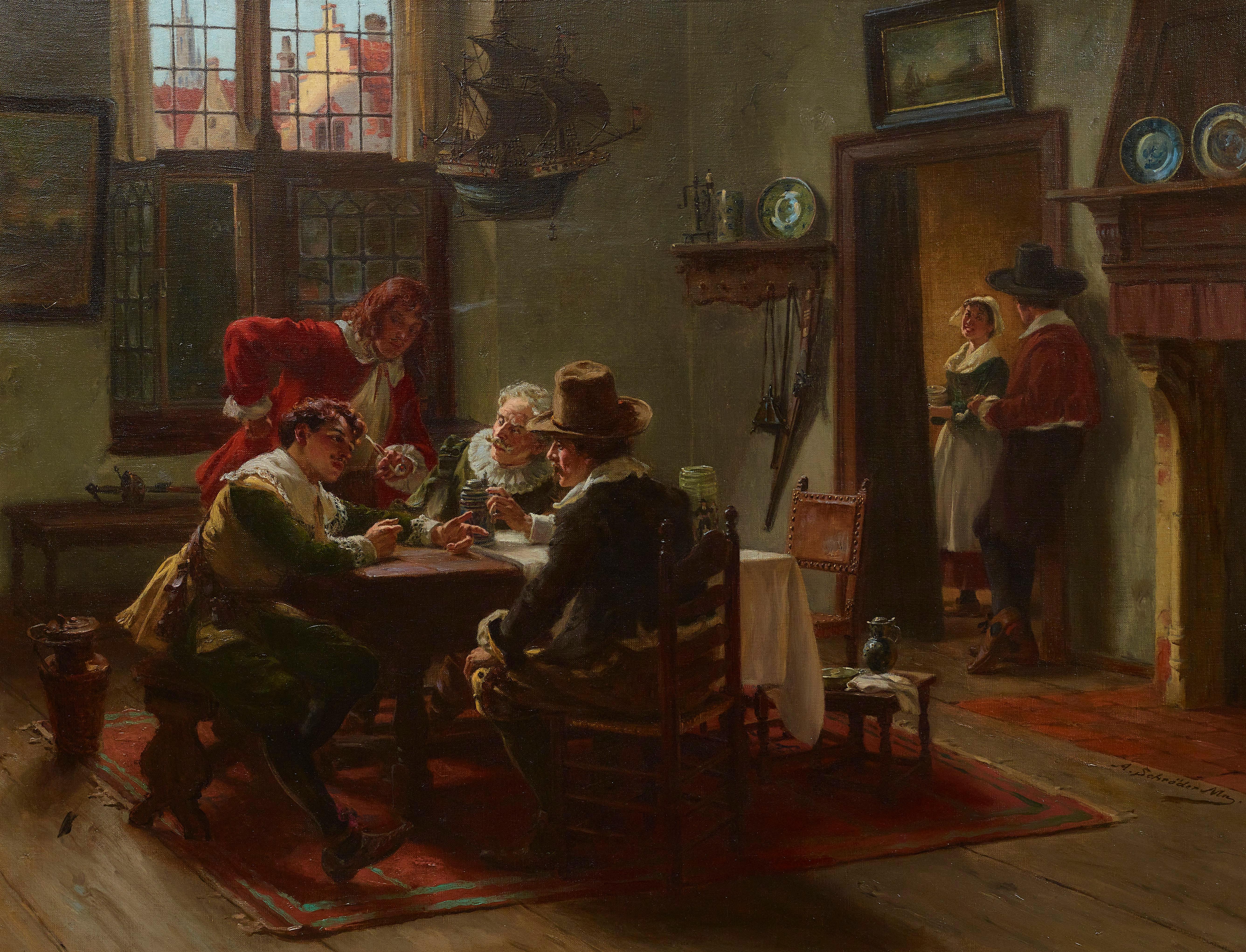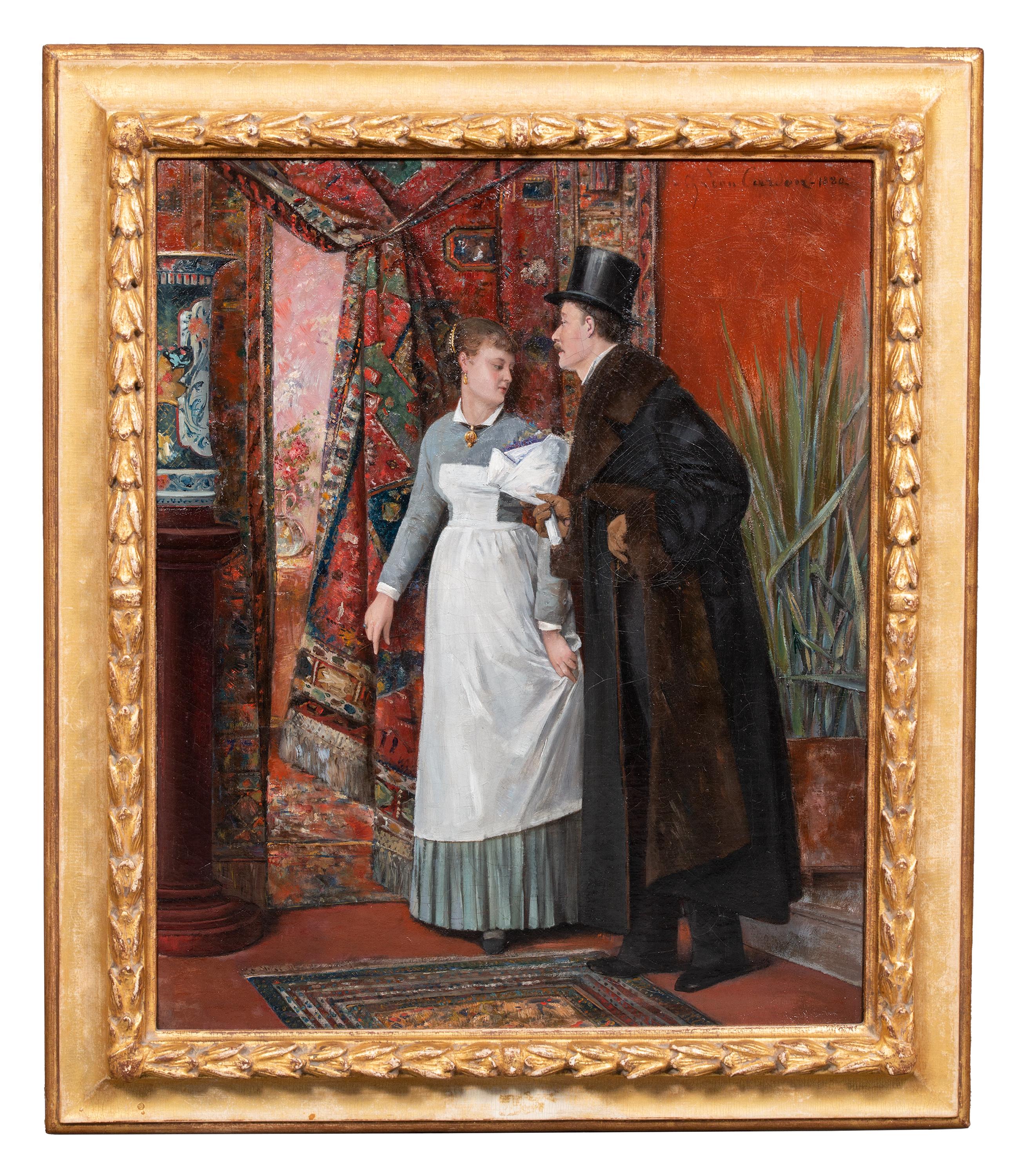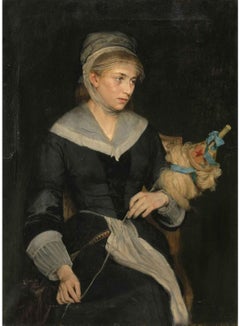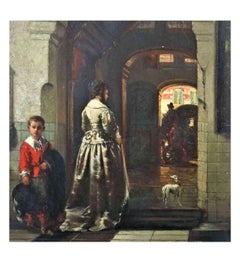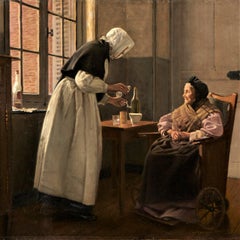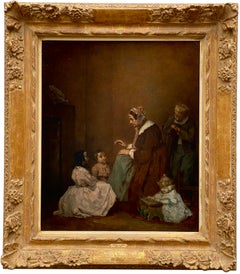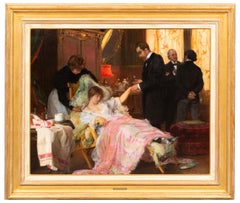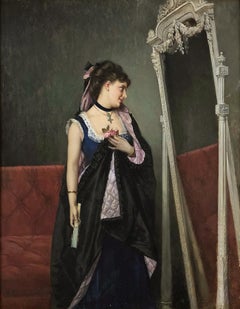Items Similar to The Embroidery Lesson - Gustave de Jonghe (1829-1893)
Want more images or videos?
Request additional images or videos from the seller
1 of 23
Gustave de Jonghe The Embroidery Lesson - Gustave de Jonghe (1829-1893)20th century
20th century
$37,303.75
£27,617.94
€31,000
CA$51,649.65
A$56,389.05
CHF 29,562.47
MX$684,866.79
NOK 369,187.18
SEK 348,611.14
DKK 236,009.62
About the Item
"The Embroidery Lesson" is a masterful representation of Gustave De Jonghe’s ability to capture the elegance and intimacy of domestic life. Through his sophisticated use of color, meticulous brushwork, and keen attention to detail, De Jonghe creates a scene that is both realistic and emotionally resonant, celebrating the warmth of familial bonds and the transmission of tradition across generations.
"The Embroidery Lesson" by Gustave De Jonghe is an intimate and carefully composed domestic interior scene. The painting features three figures: a man, a young girl, and an elderly woman, who is the girl’s grandmother. The grandmother and the girl sit closely together on a richly upholstered sofa, engaged in an embroidery lesson. The grandmother’s attentive posture and the young girl’s focus suggest a moment of shared learning and connection across generations. Meanwhile, the man, likely the girl's father, is seated in a plush red armchair on the left side of the composition, holding a paper or book. He observes the lesson with a relaxed demeanor, adding to the calm, familial atmosphere.
In the foreground, a doll is placed on a small chair, and a basket filled with colorful threads and fabrics sits beside the grandmother, emphasizing the domestic and nurturing environment. These elements not only add detail to the scene but also highlight the educational aspect of the grandmother’s role in passing down skills to the next generation. The background features an ornate fireplace, adding warmth and depth to the setting. The fireplace is decorated with an intricate clock and candelabras, further enhancing the luxuriousness of the interior. The rich decor, including the patterned carpet and wall coverings, reflects the affluence of the family.
De Jonghe utilizes a rich and harmonious color palette, with deep reds, cool blues, and soft grays dominating the scene. The red of the armchairs and the warm tones of the carpet provide a striking contrast to the cool, silvery-blue hues of the grandmother and granddaughter’s dresses, creating a visually balanced composition. The light is soft and natural, likely coming from an unseen window. It gently illuminates the figures, particularly highlighting the textures of the luxurious fabrics and the warmth of the setting. The interplay of light and shadow adds depth to the scene, enhancing the realism of the painting.
De Jonghe's brushwork is precise and meticulous, especially in the rendering of the satin fabrics and the intricate details of the interior decor. The textures are beautifully captured, from the soft sheen of the satin dresses to the rich patterns of the carpet and upholstery. The painting is a fine example of realism, a style De Jonghe excelled in. The figures are depicted with lifelike accuracy, and the environment is rendered with great attention to detail, reflecting the opulence and comfort of the bourgeois lifestyle.
The painting tells a touching story of familial bonding and the transmission of skills across generations. The grandmother is patiently teaching her granddaughter the art of embroidery, a skill likely passed down through their family. The young girl’s attentive posture and the grandmother’s focused guidance highlight the importance of this intergenerational exchange. The painting exudes a warm, nurturing atmosphere. The calm expressions and gentle interaction between the grandmother and granddaughter convey a sense of love, care, and continuity. The father’s relaxed presence further underscores the peaceful and harmonious family life depicted.
Art Historical Context:
Gustave De Jonghe was known for his detailed and elegant depictions of bourgeois domestic life, often focusing on the roles and activities of women within the home. His works, including "The Embroidery Lesson," are influenced by and share thematic similarities with those of his contemporaries, such as Alfred Stevens and Auguste Toulmouche, who also explored the quiet, refined moments of domestic life.
Gustave De Jonghe (1829–1893)
Gustave Léonard De Jonghe was born on February 4, 1829, in Kortrijk, Belgium. He was the son of the painter Jan Baptiste De Jonghe, known for his landscape paintings. Gustave was introduced to art at an early age, training under his father before attending the Royal Academy of Fine Arts in Brussels. His early education provided him with a strong foundation in the academic and technical aspects of painting, which he would later refine in his career.
De Jonghe initially focused on historical and genre scenes but eventually became renowned for his elegant depictions of women in luxurious interiors. His works are characterized by meticulous detail, rich textures, and a refined portrayal of light and color. De Jonghe's paintings often depict the leisure and domestic life of the bourgeoisie, capturing the elegance and refinement of 19th-century society.
Moving to Paris, De Jonghe became a well-established figure in the art community, regularly exhibiting at the Paris Salon, where his works were met with acclaim. His art resonated with the tastes of the Parisian elite, ensuring his success and prominence in the art world.
De Jonghe shared a close professional relationship with Alfred Stevens, another Belgian painter who similarly focused on genre scenes of fashionable women. Both artists were part of the Parisian art scene, often exhibiting together at the Salon. Their works share similarities in subject matter and style, with a mutual focus on depicting the refined and elegant lifestyles of the upper class.
Also Jules Adolphe Goupil, a French painter and art dealer, played a significant role in De Jonghe's career. Goupil was part of the prominent Goupil family, known for their influence in the art market. As an artist, Goupil was known for his detailed and polished paintings, often depicting similar subjects to those of De Jonghe. The connection between De Jonghe and Goupil was not just artistic but also commercial, as Goupil's family business helped promote and distribute the works of artists like De Jonghe. This association with the Goupil name enhanced De Jonghe's reach and reputation across Europe.
Gustave De Jonghe's work remains to be celebrated for its technical precision and its depiction of 19th-century European society's elegance.
- Creator:Gustave de Jonghe (Belgian)
- Creation Year:20th century
- Dimensions:Height: 33.46 in (84.99 cm)Width: 37.4 in (95 cm)Depth: 2.76 in (7.02 cm)
- Medium:
- Period:
- Condition:
- Gallery Location:Gent, BE
- Reference Number:1stDibs: LU2140215052922
About the Seller
5.0
Vetted Professional Seller
Every seller passes strict standards for authenticity and reliability
Established in 2018
1stDibs seller since 2022
5 sales on 1stDibs
Typical response time: 2 hours
- ShippingRetrieving quote...Shipping from: Gent, Belgium
- Return Policy
Authenticity Guarantee
In the unlikely event there’s an issue with an item’s authenticity, contact us within 1 year for a full refund. DetailsMoney-Back Guarantee
If your item is not as described, is damaged in transit, or does not arrive, contact us within 7 days for a full refund. Details24-Hour Cancellation
You have a 24-hour grace period in which to reconsider your purchase, with no questions asked.Vetted Professional Sellers
Our world-class sellers must adhere to strict standards for service and quality, maintaining the integrity of our listings.Price-Match Guarantee
If you find that a seller listed the same item for a lower price elsewhere, we’ll match it.Trusted Global Delivery
Our best-in-class carrier network provides specialized shipping options worldwide, including custom delivery.More From This Seller
View AllRenevier Julien (1847-1907), Oil on canvas+ The wool spinner
Located in Gent, VOV
"The Wool Spinner", a stunning 19th-century oil on canvas painting by renowned artist Renevier Julien, captures the essence of rural life. This exquisite piece depicts a woman deeply...
Category
Late 19th Century Realist Figurative Paintings
Materials
Oil
Charles Louis Verwee (1832-1882) A Possible Purchase
Located in Gent, VOV
The painting "A Possible Purchase" by Charles Louis Verwee, a renowned Belgian artist, captures a delicate and poignant moment. In this piece, a woman is depicted standing in an opul...
Category
19th Century Figurative Paintings
Materials
Oil
The Farewell By Johannes Stroebel (1821-1905)
Located in Gent, VOV
"The Farewell By Johannes Stroebel (1821-1905)"
Singed on the right (below)
Presented in a period frame
Johannes Anthonie Balthasar Stroebel, often also referred to as J.A.B. Stro...
Category
Late 19th Century Dutch School Interior Paintings
Materials
Oil
Afternoon tea , 1912 Oil on canvas Auguste Moreau-Deschanvres (1838-1913)
Located in Gent, VOV
Auguste Moreau-Deschanvres (1838-1913)
A student of Julien Potier at the Valenciennes academic schools, the painter Auguste Moreau-Deschanvres (1838-1913) lived in the house-studio h...
Category
20th Century Figurative Paintings
Materials
Canvas, Oil
Kurzbauer Eduard (1840 - 1879)+ Oil on canvas The Serenade
Located in Gent, VOV
Eduard Kurzbauer's enchanting “La Sérénade” transports us to the heart of an intimate 19th-century interior. In this oil painting, a woman engrossed in her needlework is interrupted ...
Category
Late 19th Century Realist Interior Paintings
Materials
Oil
Alone in the world, Oil on panel by Duwez Henri-Joseph (1810-1884)
Located in Gent, VOV
Alone in the world
Signature on the left
Presented in a period frame
Provenance: Sold in Paris on February 6, 1895, at Drouot, for 140 Gold Francs (Bénézit)
Biography Henri-Joseph ...
Category
19th Century Academic Figurative Paintings
Materials
Acrylic
You May Also Like
'La Leçon de Chant – The Singing Lesson' by Théodule Augustin Ribot, 1823 – 1891
By Théodule Augustin Ribot
Located in Knokke, BE
Théodule Augustin Ribot
St Nicolas d’Attez 1823 – 1891 Colombes
French Painter
'La Leçon de Chant – The Singing Lesson'
Signature: signed lower left 't.ribot'
Medium: oil on canva...
Category
19th Century Realist Interior Paintings
Materials
Canvas, Oil
Gustave de Jonghe, "An Afternoon Visit, " original oil painting
Located in Chatsworth, CA
Gustave de Jonghe
An Afternoon Visit
Oil on panel
Image Size: 32.8 x 25 inches
Framed Dimensions: 41.7 x 33.5
Hand signed in lower left corner
Category
1860s Romantic Portrait Paintings
Materials
Oil
'Une Consultation de Sigmund Freud' by Hubert - Denis Etcheverry (1867 – 1950)
Located in Knokke, BE
Hubert-Denis Etcheverry
Bayonne 1867 – 1950 Paris
French Painter
'Une Consultation de Sigmund Freud'
Signature: signed lower right and dated ‘D. Etcheverry / Paris 1900’
Medium: oi...
Category
Early 20th Century Realist Portrait Paintings
Materials
Canvas, Oil
A Lovely Reflection
By Auguste Toulmouche
Located in Missouri, MO
Auguste Toulmouche (1829-1890)
"A Lovely Reflection" 1874
Oil on Panel
Signed and Dated Lower Left
Site Size: approx 17 x 14 inches
Framed SIze: approx. 27.5 x 24 inches
Provenan...
Category
1870s Victorian Figurative Paintings
Materials
Oil, Wood Panel
Price Upon Request
Making the Next Move 19th Century Interior Figurative Painting Costume, dress
Located in Shrewsbury, Shropshire
Framed size: 37" x 46.5"
Signed bottom right
"Making the Next Move" is a very typical example of Schroder's work. The figures sitting around the table debating their "next move" t...
Category
19th Century Victorian Figurative Paintings
Materials
Canvas, Oil
'A Gentleman and a Maid' by Charles Léon Cardon (1850 – 1921) signed, dated 1880
Located in Knokke, BE
Charles Léon Cardon
1850 – Brussels – 1921
Belgian Painter
'A Gentleman and a Maid'
Signature: signed top right and dated ‘Ch. Léon Cardon - 1880’
Medium: oil on canvas
Dimensions...
Category
Late 19th Century Impressionist Interior Paintings
Materials
Canvas, Oil
More Ways To Browse
Embroidery Art
Vintage Embroidery Art
1893 Painting
Vintage Basket Chairs
Oil Portrait Irish
Portrait Of Woman 1970s
Portrait Xviii
Relax Sign
Titan Fine Art
Vincent Desiderio
50s British Art
Baron Oil Painting
Cadre Dore
Civil War Portrait
Jonathan Richardson
Le Sueur
Oil Portrait Of Young Blonde Girl
Society Portraits Oil Painting
